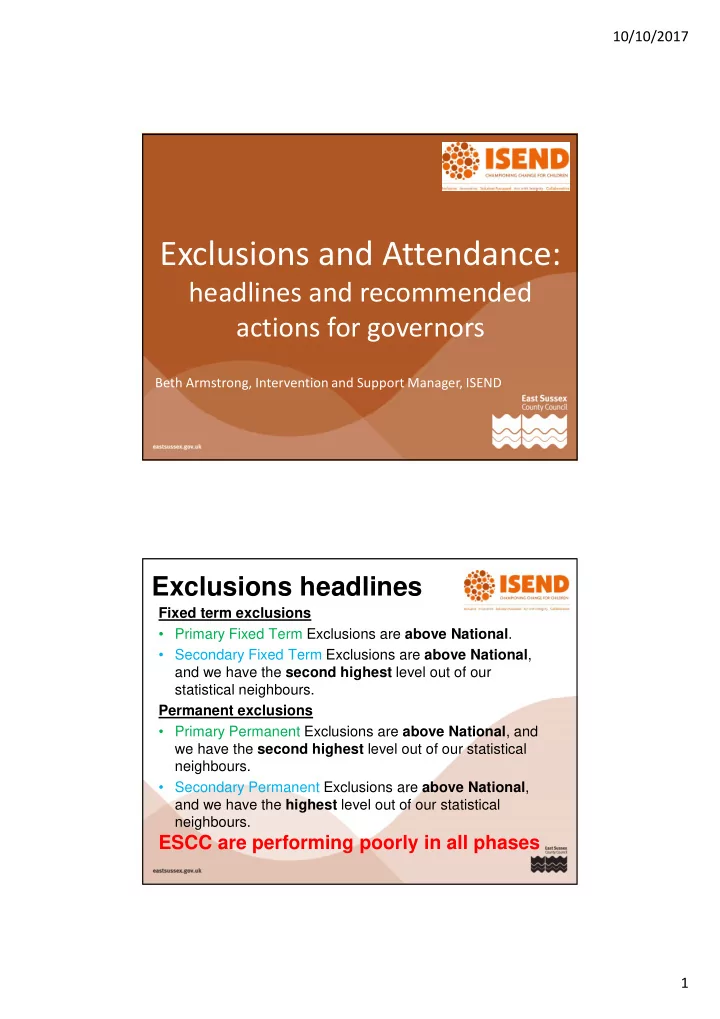

10/10/2017 Exclusions and Attendance: headlines and recommended actions for governors Beth Armstrong, Intervention and Support Manager, ISEND Exclusions headlines Fixed term exclusions • Primary Fixed Term Exclusions are above National . • Secondary Fixed Term Exclusions are above National , and we have the second highest level out of our statistical neighbours. Permanent exclusions • Primary Permanent Exclusions are above National , and we have the second highest level out of our statistical neighbours. • Secondary Permanent Exclusions are above National , and we have the highest level out of our statistical neighbours. ESCC are performing poorly in all phases 1
10/10/2017 Attendance headlines Overall absence • Overall absence at primary 4.6% (national average 4.0%) • Overall absence at secondary 5.7% (national average 5.2%) Persistent absence (90% attendance or lower) • Percentage of pupils who are persistently absent at primary 10.2% (national average 8.2%) • Percentage of pupils who are persistently absent at secondary 15.0% (national average 13.1%) ESCC are performing poorly in all phases Attendance headlines Out of 152 Local Authorities in England: ESCC primary phase • Joint 13 th worst persistent absence figures in England • Joint 3 rd worst overall absence figures in England • Joint 3 rd highest authorisers of absence in England ESCC secondary phase • Joint 20 th worst persistent absence figures in England • Joint 17 th worst overall absence figures in England • Joint 16 th highest authorisers of absence in England 2
10/10/2017 Lines of enquiry for Governors • Have the school’s permanent or fixed-term exclusions risen sharply, remained high over time, or are they disproportionate for a particular group? • High exclusions and poor attendance mean that pupils are missing learning time – what does progress data look like in the school? • High exclusions can indicate a lack of strategies to manage and improve behaviour – what do learning walks reveal? • The impact of exclusions and poor attendance is greater for children with SEND - what tracking and reasonable adjustments are in place? • Are Governors/Directors aware of any behaviour and safety or attendance actions from the previous Ofsted Inspection? • Are exclusions and/or attendance on the school improvement plan? How are you tracking progress and checking for impact? To know where to go for further guidance: – the DfE ‘Exclusion from maintained schools, academies and pupil referral units in England’ statutory guidance (2017) https://www.gov.uk/government/publications/school-exclusion – The Education Act (2002) as amended by the Education Act (2011) http://www.legislation.gov.uk/ukpga/2011/21/contents/enacted – The Equality Act (2010) https://www.gov.uk/equality-act-2010-guidance http://www.legislation.gov.uk/ukpga/2010/15/contents – The SEND Code of Practice (2014) https://www.gov.uk/government/publications/send-code-of-practice-0-to-25 – Schools’ use of exclusion (frequently asked questions Nov 2014, Ofsted) https://www.gov.uk/government/publications/schools-use-of-exclusion – Unannounced behaviour inspections guidance for Inspectors (Jan 2015) https://www.gov.uk/government/publications/unannounced-behaviour-inspections- guidance-for-inspectors 3
10/10/2017 Where to go for support : ESCC Guidance: https://czone.eastsussex.gov.uk/inclusion-and-send/isend- services/education-support-behaviour-and-attendance-service-esbas/ Front door (core) referrals: https://czone.eastsussex.gov.uk/inclusion-and-send/front-door-referrals/ Traded referrals: https://www.services2schools.co.uk/services/listservices/10 Governor training on exclusions from ESBAS: Adam.Brazier@eastsussex.gov.uk 4
Recommend
More recommend